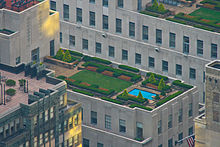 | This is a user sandbox of Gcanino32. You can use it for testing or practicing edits. This is not the sandbox where you should draft your assigned article for a dashboard.wikiedu.org course. To find the right sandbox for your assignment, visit your Dashboard course page and follow the Sandbox Draft link for your assigned article in the My Articles section. |
Green Roofs in the built environment are a revolutionary way to improve the urban forest in cities and reduce the harmful effects that are created by infrastructure and development. There are countless benefits that green roofs provide and the ability they have to mitigate environmentally harmful pollutants and practices in cities is monumental. Due to the amount and proximity of impervious surfaces and buildings in cities, heat islands are created which not only pose harmful effects on the environment but also to the people that live in these places. It has been a challenge in the urban forestry community to mitigate these effects since there is very little space to plant trees, leading the urban forestry community to look past it and accept that there is only so much canopy coverage that can be accomplished in cities. Green Roofs are the answer and can change this theory for good.

Green Roofs have the capability to decrease heat island effects, decrease storm-water runoff, improve air quality, increase energy efficiency, increase roof membrane durability, reduce electromagnetic radiation, reduce noise, increase building insulation, improve efficiency of HVAC equipment, reduce greenhouse gas emissions, improve water usage, improve aesthetics and provide urban amenities. [1][2] These benefits are only the tip of the iceberg and new benefits are been discovered every day. Buildings that use green roofs have been found to have recorded temperatures of 30-40°F lower than conventional roofs. [3] If every building in a city used green roofs the heat island would drastically decrease the heat island to almost zero which would benefit the environment and create more desirable living conditions, which would attract more people to live in cities. Due to the heavily populated nature of cities and the pollution that is created by traffic, construction and the heating of buildings green roofs can be used to purify the air and be used as a natural filter for these pollutants. Not only can trees convert carbon dioxide into oxygen through photosynthesis, but they can capture airborne pollutants, atmospheric deposition, and also filter noxious gases from the air that stick to the trees bark leaves which are then absorbed into the tree itself.[1] Green Roofs can improve improve HVAC equipment by absorbing the ultra violet rays from the sun in the warmer months of the year which exposes the building to less heat therefore cooling the building down and warming it up in the winter through its insulating capabilities, easing the workload of HVAC equipment. Consequentially, if the HVAC equipment does not have to work as hard to cool a building down it will then use less energy supporting the evidence that green roofs improve energy efficiency. As a result of this effect on HVAC equipment green roofs also reduce greenhouse gas emissions by decreasing the workload of HVAC equipment which reduces the amount of fossil fuel combustion required to run the equipment. Water Quality can also be positively effected by green roofs as rain fall is filter through the green roof media which eventually evaporates due to evapotranspiration resulting in better water quality.[4]
- ^ a b "About Green Roofs". Green Roofs for Healthy Cities. Retrieved 2022-04-16.
- ^ "Green Roof Benefits—Technical Preservation Services, National Park Service". www.nps.gov. Retrieved 2022-04-16.
- ^ US EPA, OAR (2014-06-17). "Using Green Roofs to Reduce Heat Islands". www.epa.gov. Retrieved 2022-04-16.
- ^ "Overview for green roofs - Minnesota Stormwater Manual". stormwater.pca.state.mn.us. Retrieved 2022-04-16.